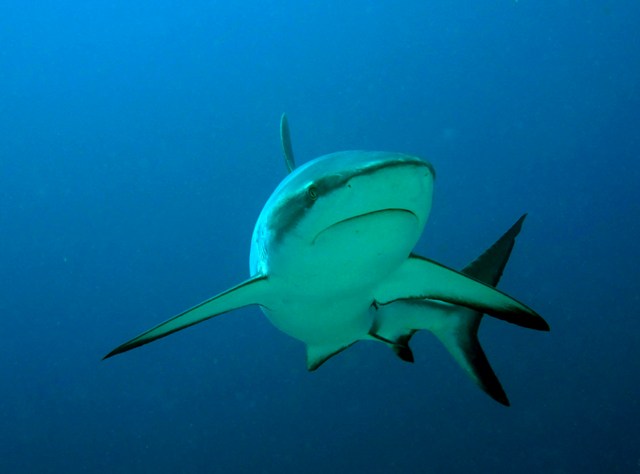By John F. Calvelli and Amie Bräutigam
Shark Week is back. The Discovery Channel's annual fear-fest has led millions of Americans -- including some of our own friends and family -- to warily scan their beach waters each August for lurking fins. It is time to look at these misunderstood fishes in a more honest light and focus attention on the urgent need to reverse their disappearance from the world's oceans.
Sharks and their relatives -- the skates, rays and chimeras -- comprise one of only two classes of living fishes: the chondrichthyan, or cartilaginous, fishes. These fishes have lived on Earth for over 400 million years. Numbering around 1,100 species and exhibiting enormous diversity, they are marvelous for so much more than their undeserved reputation as fierce predators.

©R.T. Graham
Take the whale shark and basking shark. The world's two largest fishes are plankton-eaters, posing no risk to humans. Gracefully gliding manta rays, with wingspans seven meters long, give birth to only one live pup every two to three years. With considerable life spans, late maturity, and generally long gestation periods, sharks are vulnerable to overfishing and recover slowly from depletion.
Sawfishes -- large, shark-like rays with a long flat snout studded with teeth on either side - are so iconic among West African cultures that they feature on every coin and bank note of the African Financial Community. The roughly 50 species of guitarfishes -- half shark, half ray, with their flattened forebodies and shark-like tails -- give birth to live young and can grow to lengths of ten feet as adults.
These and the many other chondrichthyans constitute a richness of marine life that is truly remarkable. Yet they are disappearing. Overfishing to supply global markets for meat, oil, leather, fins, curios, and other products has eliminated many species of sharks and rays from portions of their range. Demand by Chinese consumers for the high-status shark fin soup is particularly troubling.

©Stacy Jupiter
A comprehensive assessment of sharks and rays' conservation status by the International Union for the Conservation (IUCN) found just under 20 percent of sharks and rays to be threatened with extinction, with the future of three-quarters in doubt. Despite these findings, most shark and ray fisheries are either unregulated or only minimally regulated. Most threatened species remain unprotected.
About half of the world's estimated 38 million annual shark and ray fishery landings occur in a mere handful of countries -- notably India, Indonesia, Spain, and Taiwan. However, these animals are fished globally by industrial and artisanal fleets, seine net fishermen, and subsistence fishers in the waters of over 100 countries. International market demand for fins is the primary driver of this relentless pressure.
The decline and disappearance of sharks and rays is both a biodiversity loss and a threat to the livelihoods of the fishers and other users, including the dive tourism industry, for whom these species are a resource.

© Dennis DeMello/WCS
In March this year, the 178 government members of the Convention on International Trade in Endangered Species of Wild Fauna and Flora (CITES) agreed to regulate the trade in several highly sought-after shark and ray species, including the mantas. The support of so many countries marked a milestone for sharks and for marine conservation more generally.
As hard as that effort was, it pales in comparison with the work that begins now to bring fisheries and trade in shark and ray species into a management framework that ensures that they are legal, sustainable, and transparent.
To achieve that goal, the global community must commit the resources - political, technical, and financial - to safeguard the future of sharks and rays. That means adopting laws and regulations specific to these fishes, putting in place trade controls and fisheries management measures and effective monitoring, engaging fishers and other users, and initiating species recovery efforts.

© Keith A. Ellenbogen
All of this will take significant funding and collaboration. The European Union has committed 1.2 million euros to this effort, but many times that is needed -- from governments, development assistance agencies, and the private sector. Only investment at the scale of this global problem will be able to stem the loss of sharks and rays.
As the shocking shark videos begin rolling out this month, remember that these "monsters of the sea" are in fact quite vulnerable. They need significant interventions if they are to continue to feed our imaginations. Rather than conjuring killers, we look forward to one day celebrating Shark Week as an observance of these magnificent fishes' healthy recovery.
-------------------------------------------------------------------------------------------
John F. Calvelli is Executive Vice President for Public Affairs at the Wildlife Conservation Society and Chair of the Executive Committee of the International Conservation Partnership (ICP), which is comprised of representatives from the major global U.S. conservation organizations. Amie Bräutigam is WCS Marine Policy Director.
